Rhodochrosite is light pink to deep red in color and is often found in silver mines. The attractive patterns combined with rhodochrosite’s deep red color make it fairly easy to identify and gemstone collectors have been collecting top-quality pieces for years.
Well-formed translucent rhodochrosite crystals are incredibly rare and highly sought after. The colors can vary from raspberry red to various shades of pink.
During the 1930s, rhodochrosite became popular as an ornamental stone. It wasn’t until another ten years before the beautiful gem began being used in jewelry. Despite being used for decorative purposes, rhodochrosite is fragile and soft. These properties make cutting and polishing the stones difficult but lapidary artists have perfected their craft over the years to produce high-quality stones.
How to Identify Rhodochrosite Through Testing
There are various ways to identify rocks, minerals, crystals, and gemstones, but we will use a method I learned while attending the Gemological Institute of America. If you’ve learned a unique way to identify gems, please share it with us.
Let’s look deeper into how to identify rhodochrosite like a pro.
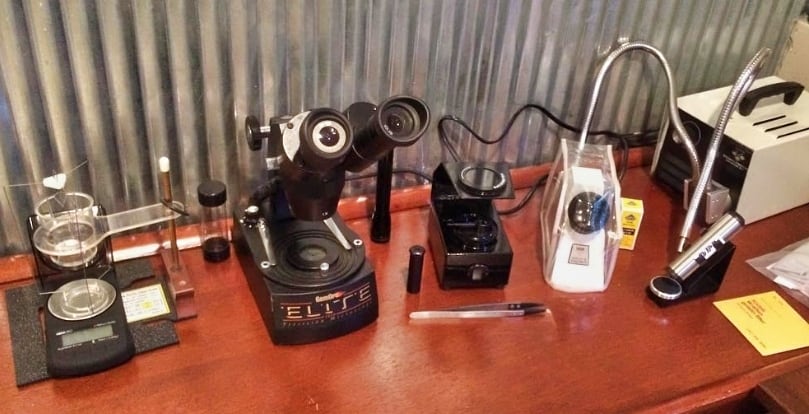
Visual Inspection
The visual inspection starts with what form of rhodochrosite you have. The questions below are relatively easy to answer, but each type will have its own process for identifying them.
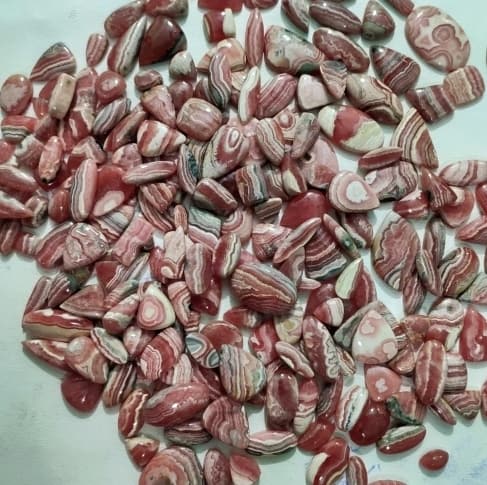
Is it a cabochon? A cabochon should have a low to medium polish with some pitting and this is due to rhodochrosite’s softness. Most soft minerals will not take a high polish. When looking at the cabochon you’ll notice white and red banding. From time to time you’ll come across cabochons with a slightly transparent red color with minimal white banding.
If you need help valuing and pricing Rhodochrosite then use my free guide.
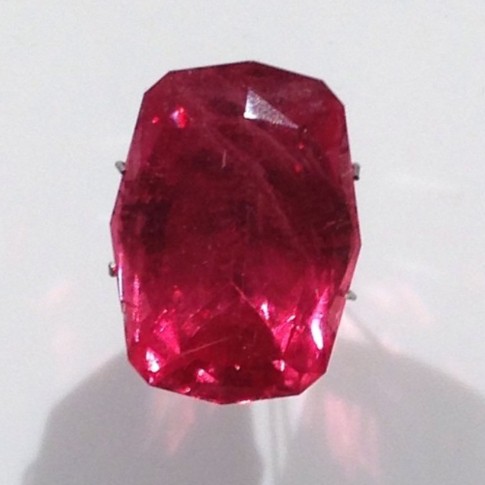
Is it faceted? Faceted rhodochrosite is very rare and you won’t come across it very often because it’s not durable. The color will be a rich red with eye-visible inclusions. More than likely the faceted gemstone will be on the light side, probably 1 to 5 carats.
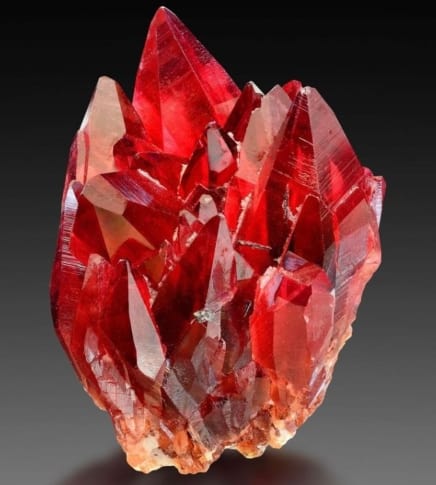
Is it a specimen? Rhodochrosite is found in different forms. You’ll better identify these forms by looking at and inspecting this mineral over time. Here’s a list of characteristics rhodochrosite displays when it’s a specimen.
- Light pink to raspberry rose in color.
- Banded specimens are common.
- Most crystal specimens are small, about the size of a quarter.
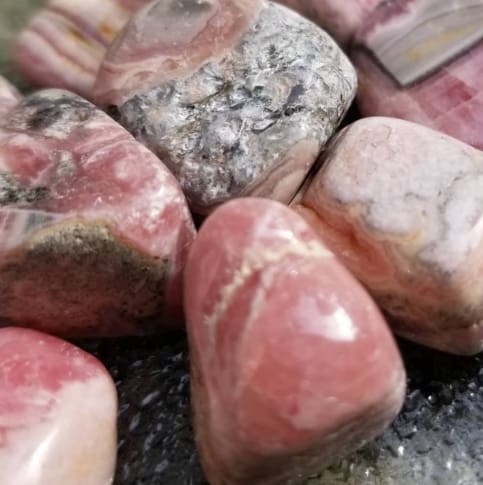
Is it tumbled? Very common to find tumbled rhodochrosite. Again, there will be a low to medium polish due to its hardness.
Physical Properties of Rhodochrosite
Let’s take a look at the physical properties of rhodochrosite. Knowing what to look for will help you more easily identify what you’re looking at.
Color: Pink, Rose, Raspberry Red, Pale Rose, Banded
Clarity / Transparency: Transparent, Translucent
Luster: Pearly, Vitreous
Cleavage: Perfect on {1011}
Fracture: Irregular, Uneven, Conchoidal
The Streak Test
This is a destructive test, so you need to ensure that you’re allowed to damage the specimen or stone if you choose to use this method. Once you’ve developed robust knowledge in identifying rocks and minerals, you won’t use destructive tests.
A mineral streak test is when you scrape the stone against a harder surface to see what color remains. Rhodochrosite produces a white streak.
Tumbled specimens are tested by scraping samples across a piece of ungalvanized porcelain, typically known as a streak plate.
Magnet Test
Faceted rhodochrosite gems are highly magnetic. Gems of an average size can be picked up by N52 magnets.
Hardness Test
I don’t recommend actively testing the hardness of a stone because it’s destructive in nature and doesn’t really provide a definite answer to what type of stone it is. That said, rhodochrosite has a hardness of 3.5 to 4 on the Mohs hardness scale.
Refractive Index Test
Determining the refractive index, or RI as it’s referred to by gemologists, for rhodochrosite is relatively straightforward, but you’ll need a specific piece of test equipment and the RI fluid to go with it. Before you place the stone on the refractometer, you want to make sure you have a flat, somewhat polished surface to take a reading.
Rhodochrosite’s Refractive Index: 1.6 to 1.82
Each gemstone has its own RI, so discovering a sample’s RI can help you figure out what sort of stone it actually is.
Step 1 – Place a small bead of RI fluid on the metal surface of the refractometer near the back of the crystal hemicylinder (the window on which the stone will sit).
Step 2 – Place the stone facet face down on the fluid dot and slide it toward the middle of the hemicylinder crystal using your fingers.
Step 3 – Look through the viewer lens without magnification. Continue looking until you see the outline of a bubble, then look at the bottom of this bubble. Take the reading from there, rounding the decimal to the nearest hundredth.
Occasionally, you’ll run into the issue of not having a flat surface to work with. In this instance, you’ll need to leave the top of the refractometer open and hold the rounded stone with your hand. Hopefully, you’ll be able to pull a reading off of the gauge.
Birefringence Test
Consider testing the birefringence, as well. Birefringence is related to RI. While doing the birefringence test, you will turn the gemstone on the refractometer six times throughout the observation period and note the changes.
Perform a standard RI test. Instead of keeping the stone still, gradually turn it 180 degrees, making each separate turn about 30 degrees. At each 30-degree mark, take a new RI reading.
Subtract the lowest reading from the highest to find the stone’s birefringence. Round it to the nearest thousandth.
Birefringence: δ = 0.0218
Single or Double Refraction
Rhodochrosite has a double refraction.
The stone must be transparent for this test to be accurate and beneficial. If the light won’t pass through the stone, there is no way to test for single or double refraction.
Check for single or double refraction. Use this test on translucent and transparent stones. You can determine whether the stone is only singly refractive (SR) or doubly refractive (DR) to help identify it. Some stones can also be classified as aggregate (AGG).
Turn on the light of a polariscope and place the stone face down on the lower glass lens (polarizer). Look through the top lens (analyzer), turning the top lens until the area around the stone looks darkest. This is your starting point.
Turn the analyzer 360 degrees and watch how the light around the stone changes.
If the stone appears dark and stays dark, it is likely an SR. If the stone starts out light and remains light, it is likely AGG. If the lightness or darkness of the stone changes, it is likely DR.
Checking The Diaphaneity
Diaphaneity refers to the mineral’s ability to transmit light. For instance, some minerals are transparent or translucent. A small amount of distortion might occur when they’re thick, but light will pass through them relatively freely.
Rhodochrosite is translucent to subtranslucent.
Finding The Specific Gravity
Every stone has its unique specific gravity, which helps us identify them. Specific gravity is one of the best properties to measure when identifying mineral specimens. Most minerals have a narrow range of specific gravity, so getting an accurate measurement can go a long way toward identification.
Specific gravity is a unitless number describing how heavy a mineral is compared to equal volumes of water. For example, if a mineral is three times as dense as water, it’ll have a specific gravity of three. This is useful because while two minerals might be the same size, they’ll each have a different specific gravity.
The larger the sample, the more precise the readings tend to be. Remember that this technique can only be used for single mineral or crystal masses. It will not work for minerals embedded in host rocks.
Rhodochrosite’s Specific Gravity: 3.7
As helpful as specific gravity is for identifying minerals, amateurs are usually constrained by the need for more necessary tools for the job. However, one way to work around this is to hold the specimen and note how heavy or heft it feels compared to what you might expect a specimen of that size to weigh.
If you want to determine the specific gravity of your stone like a pro, you’ll need to invest in a higher-end scale. The OHAUS Density Determination Kit is the one gemologists use.
Identifying Rocks and Minerals Like a Pro
Hopefully, you feel confident in your practice of identifying a piece of rhodochrosite after reading and applying this guide. You’ll be using the visual part of this guide the most, and you’ll get better as you interact with more gemstones. Before you know it, you’ll be identifying stones like a gemologist.
Feel free to reach out if you encounter any issues or need clarification. I’ll do my best to assist you in the identification process.
- Identify Enstatite - March 12, 2024
- Identify Cerussite - March 3, 2024
- Identify Bytownite - February 18, 2024

2 Responses
Hi Jerred! I was searching online for info on how to identify Rhodochrosite and came across your very interesting article. I am wondering if you can help me identify a stone sphere/orb that belonged to my friend’s deceased family member. She would like to sell it and asked me to help her with that. I have a small shop on Etsy where I sell vintage items. I know nothing about stones/minerals though. Someone with some knowledge told me that they think it may be Rhodochrosite. It is 4 inches in diameter and has a flat bottom, so it sits on its own. It probably dates to the 1950s or maybe earlier. It has some type of old clear coating on it that has worn away in some areas. Where the coating has worn away, the stone is unpolished. The clear coating has yellowed somewhat over the years. Maybe you can help solve the mystery if I send you a few photos? Thank you!
Loretta – I emailed you directly.